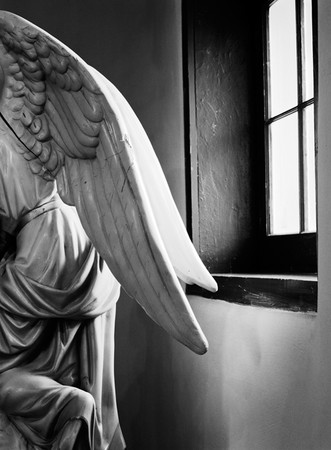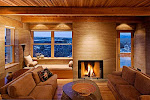Architecture is the crucible of HDR programs. The hard edges between light and dark areas generate halos etc. Up to this point I ALMOST ALWAYS found it better to light the site artificially rather than try and make an HDR image look decent. Don't think I didn't try. I own or have tried most if not all the HDR programs out there and largely given up in frustration.
Then came Lightroom 3 and the Enfuse Plugin. I have much testing to do, but my initial tests show great potential. The test below (bottom) is the DEFAULT settings from a 2 stop exposure bracket, straight from the DNGs in LR3. The image on the top is the unaltered "middle" exposure. Hmmmm........
Architecture by Dekker Perich Sabatini-Albuquerque, Las Vegas and Amarillo. The University of Nevada Reno Center for Molecular Medicine in Reno Nevada.
Now you might say that this could be done by boosting the Recovery and Fill Light sliders and.......yes you could and I did, but you concurrently generate pattern noise in the shadows you boost. Enfuse's method of sampling the shadows from the brightest exposure creates bright shadows with zero noise (this is typical of all the HDR programs I have tested).
This HDR'd result tries to more closely mimic the eyes experience of the scene where the eye dilates as it moves from shadowed areas to the windows. If you overdue it, bringing the window light down further, the lack of brightness in the windows seems unnatural resulting in that overdone HDR effect.
Tuesday, September 28, 2010
Sunday, September 19, 2010
Have you been waiting for the Canon upgrades to the 90 and 45 T/S lenses? Lenses on par with the new 24T/S II and 17? Schneider jumps in with some mighty contenders!
Schneider T/S
According to recent reports from Photokina, these lenses have manual apertures, which at this price point is a real drag.
Schneider T/S
According to recent reports from Photokina, these lenses have manual apertures, which at this price point is a real drag.
Saturday, September 18, 2010
Scanning for Fine Art Images
Imacon "Virtual Drum Scan" vs. Epson 750 home scan vs. Aztec Premium Drum Scan
Frankly most of my serious efforts with scanners and scans revolve around my B&W work. Of course I have, prior to digital, had thousands of my commercial color transparencies scanned for magazines, books, posters etc. but I was rarely involved in that. For a couple of years, just prior to digital, I did do allot of my own scanning for commercial publication because I was behind the times and everyone just wanted files. I never found that a home scanner like an Epson 750 (in my hands) could deliver what a commercial drum scan could deliver on transparencies for publication. They suffered in the shadow areas, highlight separation, color fidelity etc. I never had any complaints from clients, but I could see the difference.
It is certainly true IME that the major differences of home flatbeds and pro drum scans lies in resolution and in the renderings of the extremes of the tonal range. My 750 cannot pull detail out of deep shadows anywhere close to a good drum scan and I believe at the other end of the scale in the highlights that there is some flaring that takes place in home flatbeds that obscures fine detail in dense highlights.
I believe this is part of the key to maximizing tonal control from the Epson scanners. Shoot and develop for the limitations of the scanner. With a drum scan I just shoot normally using basic Zone System controls, but to maximize a scan on an Epson I would place the low values higher and develop the highlights lower.
BTW, I visited the printing service (Pat Carr-Carr Imaging-a true master) I use for large digital prints yesterday, who was working on a print of mine that I had never printed in silver or ink larger than 16x20 before (4x5 TRI-X in HC-110). I have never owned a printer that would print over 17" wide. This is a print 24x33-actually the largest art print I have ever made and is for an upcoming museum show. It was scanned by me on a well maintained Imacon at SAIC and looked superb at that size. The grain (or grain clumping I don't suppose that an Imacon can actually resolve grain) was sharp and tight and looked great even on close inspection with my reading glasses, requiring no additional sharpening than the original Imacon capture sharpening (I don't remember the setting). This was never a "look" that I could get on large prints with my Epson. As a backup I had Lenny Eiger, Eiger Studios, do a drum scan of the same image in case it didn't hold up at that size. Lenny's scan pulled more deep shadow detail out of the negative, but I didn't need it-not a wasted expense anyway-I am archiving quality drum scans of all my best images from the past 30 years.

I know Lenny's drum scan has more deep shadow detail than the Imacon, but I tend to print this pretty deep anyway. There is a fair amount of work in the file and with a tight deadline looming, I was not wanting to start over with a new scan unless I had to. But in terms of resolution the Imacon could handle this size and on this image the tones were fine too.
Frankly most of my serious efforts with scanners and scans revolve around my B&W work. Of course I have, prior to digital, had thousands of my commercial color transparencies scanned for magazines, books, posters etc. but I was rarely involved in that. For a couple of years, just prior to digital, I did do allot of my own scanning for commercial publication because I was behind the times and everyone just wanted files. I never found that a home scanner like an Epson 750 (in my hands) could deliver what a commercial drum scan could deliver on transparencies for publication. They suffered in the shadow areas, highlight separation, color fidelity etc. I never had any complaints from clients, but I could see the difference.
It is certainly true IME that the major differences of home flatbeds and pro drum scans lies in resolution and in the renderings of the extremes of the tonal range. My 750 cannot pull detail out of deep shadows anywhere close to a good drum scan and I believe at the other end of the scale in the highlights that there is some flaring that takes place in home flatbeds that obscures fine detail in dense highlights.
Quote:
| And if you take that into account when exposing and developing your film, you should be able to get as much shadow detail as you'd like in your images, even using an Epson scan. Peter De Smidt |
BTW, I visited the printing service (Pat Carr-Carr Imaging-a true master) I use for large digital prints yesterday, who was working on a print of mine that I had never printed in silver or ink larger than 16x20 before (4x5 TRI-X in HC-110). I have never owned a printer that would print over 17" wide. This is a print 24x33-actually the largest art print I have ever made and is for an upcoming museum show. It was scanned by me on a well maintained Imacon at SAIC and looked superb at that size. The grain (or grain clumping I don't suppose that an Imacon can actually resolve grain) was sharp and tight and looked great even on close inspection with my reading glasses, requiring no additional sharpening than the original Imacon capture sharpening (I don't remember the setting). This was never a "look" that I could get on large prints with my Epson. As a backup I had Lenny Eiger, Eiger Studios, do a drum scan of the same image in case it didn't hold up at that size. Lenny's scan pulled more deep shadow detail out of the negative, but I didn't need it-not a wasted expense anyway-I am archiving quality drum scans of all my best images from the past 30 years.

I know Lenny's drum scan has more deep shadow detail than the Imacon, but I tend to print this pretty deep anyway. There is a fair amount of work in the file and with a tight deadline looming, I was not wanting to start over with a new scan unless I had to. But in terms of resolution the Imacon could handle this size and on this image the tones were fine too.
Friday, September 3, 2010
The Dwell Effect
I have been discussing, off and on, the impact on our business of the popular magazine Dwell. It is not an abstract discussion as myself and many photographers I know have been asked to imitate that "Dwell Look". Well here is my latest, an art directed example for one of my favorite locally based national magazines.
The original a flat stitch of one of the reject poses with the camera in a horizontal position. The stitch was requested to insure that they had enough real estate to work from. There was great natural light that just needed to be slightly boosted and the ambient color to be cleaned up. Two lights were used, a fill bounced off the white wall behind me and one in the kitchen set slightly brighter to pull the eye in. When doing these kind of stitches, it is only necessary to shoot the left side once, but the right side with the home owner multiple times, in different poses, and then stitch the selected right side of the woman with the previously shot left side. This was a difficult stitch as there was not much detail in the overlap area for the program, PS CS4 to find reference points. I ended up manually stitching these. The right example has been cropped in some already at this point. The merge area is between the chairs.
Unfortunately I had to manually stitch a number of these before the art director decided which she wanted. Left-the final published cover. Right-one of the rejected poses.
The most recent cover in the same vein.
Subscribe to:
Comments (Atom)

















